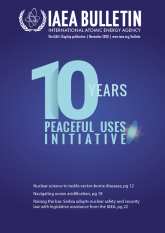This year marks a decade of action under the Peaceful Uses Initiative (PUI). Far reaching in scope and impact, the PUI has enabled us to expand our horizons to support developing Member States and confront some of the most pressing and — at times — unanticipated global challenges. From supporting cancer control programmes, to increasing food security and enhancing nuclear safety, projects under the PUI have been instrumental in increasing the contribution of the peaceful use of nuclear science and technology to development.
In the last ten years, the initiative has mobilized €174 million in extrabudgetary contributions from 24 countries, the European Commission and the private sector. More than 300 projects have been implemented, benefiting over 150 Member States (read more here). Several countries have made multi-year funding pledges to the PUI, making funding more reliable. This is particularly beneficial for long-term, large-scale projects where predictability is key. As the world faced unexpected challenges, such as the Zika virus disease and now COVID-19, the PUI has enabled the IAEA to respond quickly and flexibly to the evolving priorities of Member States.



